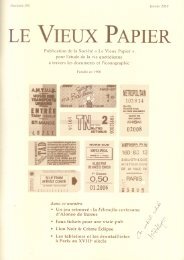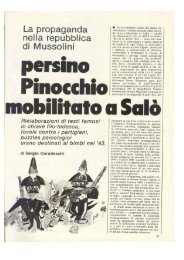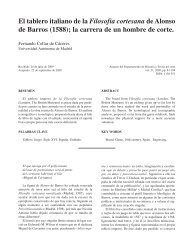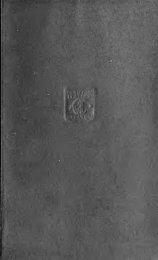Board games from the city of Vijayanagara (Hampi ... - Gioco dell'Oca.
Board games from the city of Vijayanagara (Hampi ... - Gioco dell'Oca.
Board games from the city of Vijayanagara (Hampi ... - Gioco dell'Oca.
Create successful ePaper yourself
Turn your PDF publications into a flip-book with our unique Google optimized e-Paper software.
12<br />
B OARD G AME S TUDIES 6, 2003<br />
Vilhelmina is situated in an area with a mixed Swedish- and Sámi-speaking population,<br />
while Boda is situated to <strong>the</strong> south <strong>of</strong> <strong>the</strong> part <strong>of</strong> Sweden inhabited by Sámit. It<br />
seems that we have no evidence <strong>of</strong> this game being played in Denmark, Norway or by<br />
<strong>the</strong> Sámit in Sweden or Norway, nor do we know <strong>of</strong> any parallels to <strong>the</strong> particular dice<br />
stick used in Boda. The somewhat different shape <strong>of</strong> <strong>the</strong> dice, combined with <strong>the</strong> eastern<br />
distribution area <strong>of</strong> this game makes it ra<strong>the</strong>r unlikely that <strong>the</strong>re was any direct connection<br />
between this type <strong>of</strong> stick dice and that used in daldøs(a) and sáhkku.<br />
It would certainly be interesting to know more about <strong>the</strong> dice sticks used in <strong>the</strong><br />
Finnish and Estonian versions <strong>of</strong> this game, but I have not been able to find any information<br />
about that subject.<br />
‘Put-and-take’ teetotums and dice sticks<br />
In a recent article in Danish (Michaelsen 2002) I have discussed various designations<br />
<strong>of</strong> ‘put-and-take’ and teetotum <strong>games</strong>. A large part <strong>of</strong> my article is devoted to <strong>the</strong><br />
Danish dialect names used for <strong>the</strong>se <strong>games</strong>, but I also discuss a number <strong>of</strong> foreign game<br />
names. Various variants <strong>of</strong> sáhkku were played along <strong>the</strong> coasts <strong>of</strong> Nordland, Troms and<br />
Finnmark in Nor<strong>the</strong>rn Norway, in <strong>the</strong> area around <strong>the</strong> Norwegian-Russian border, in <strong>the</strong><br />
extreme north <strong>of</strong> Finland, on Spitzbergen, and in Siberia. (8)<br />
At least two Sámi peoples used to play not only sáhkku, but also a much simpler<br />
game <strong>of</strong> chance with dice. This tradition was described by Toivo Immanuel Itkonen in<br />
1941. (9) The Skolt Sámit used to play with a 4- or 8-sided dice top, named kieppa-ker’tsa,<br />
which had numbers on it. The four-sided top had an X and vertical or horizontal<br />
lines (Fig. 4), while <strong>the</strong> eight-sided top had a blank side and Arabic numbers <strong>from</strong> 1-7<br />
or an X and numbers <strong>from</strong> 15-21.<br />
The Inari Mountain Sámit <strong>of</strong> Nor<strong>the</strong>rn Finland played with an 11-sided dice top,<br />
named pir’tsu like <strong>the</strong> sáhkku game and <strong>the</strong> dice used in that area. Each side had 1-10<br />
horizontal cross lines indicating <strong>the</strong> number <strong>of</strong> points. The eleventh, blank side corresponded<br />
to zero points (Fig. 5). This was spun around in a kneading-trough, around<br />
which <strong>the</strong> participants, not more than 11 persons, were sitting. The Swedish-speaking<br />
minority <strong>of</strong> Finland knew a similar tradition, playing a game <strong>of</strong> chance with a four-sided<br />
trissa, which was a dice top with 1-4 ristor (strokes). (10)<br />
It is easy to find points <strong>of</strong> resemblance between <strong>the</strong> design <strong>of</strong> <strong>the</strong>se dice tops and <strong>the</strong><br />
design <strong>of</strong> <strong>the</strong> sáhkku dice. It is much more difficult to tell how <strong>the</strong>se similarities arose.<br />
The tradition <strong>of</strong> using crosses, cross lines, and blank sides on <strong>the</strong> dice is probably older<br />
among <strong>the</strong> Sámit than <strong>the</strong> use <strong>of</strong> Arabic numerals. We know <strong>from</strong> Johannes Scheffer’s<br />
Lapponia, printed in Frankfurt in 1673, that <strong>the</strong> Sámit north <strong>of</strong> <strong>the</strong> Bothnic Bay already<br />
<strong>the</strong>n used to play with wooden dice with a cross cut into one <strong>of</strong> <strong>the</strong> sides. (11)<br />
Cross lines and o<strong>the</strong>r lines resembling Roman numerals are also found on <strong>the</strong> sticks<br />
used in a variant <strong>of</strong> <strong>the</strong> spellicans or jackstraw game, played by Sámit and Swedes in<br />
Jämtland in Nor<strong>the</strong>rn Sweden. In Swedish this game is called påfvespel (‘pope game’) or<br />
stöupstickan. (12) (Fig. 6) Some <strong>of</strong> <strong>the</strong> signs on <strong>the</strong>se sticks are very similar to those found<br />
on <strong>the</strong> sáhkku dice, but, on <strong>the</strong> o<strong>the</strong>r hand, possible non-European parallels make it<br />
plausible that to some extent such markings are actually universal symbols. (13)







